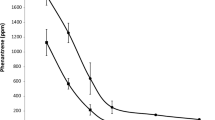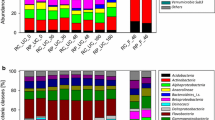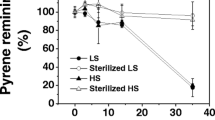Abstract
Development of successful bioremediation strategies for environments contaminated with recalcitrant pollutants requires in-depth knowledge of the microorganisms and microbial processes involved in degradation. The response of soil microbial communities to three polycyclic aromatic hydrocarbons, phenanthrene (3-ring), fluoranthene (4-ring) and benzo(a)pyrene (5-ring), was examined. Profiles of bacterial, archaeal and fungal communities were generated using molecular fingerprinting techniques (TRFLP, ARISA) and multivariate statistical tools were employed to interpret the effect of PAHs on community dynamics and composition. The extent and rate of PAH removal was directly related to the chemical structure, with the 5-ring PAH benzo(a)pyrene degraded more slowly than phenathrene or fluoranthene. Bacterial, archaeal and fungal communities were all significantly affected by PAH amendment, time and their interaction. Based on analysis of clone libraries, Actinobacteria appeared to dominate in fluoranthene amended soil, although they also represented a significant portion of the diversity in phenanthrene amended and unamended soils. In addition there appeared to be more γ-Proteobacteria and less Bacteroidetes in soil amended with either PAH compared to the control. The soil bacterial community clearly possessed the potential to degrade PAHs as evidenced by the abundance of PAH ring hydroxylating (PAH-RHDα) genes from both gram negative (GN) and gram positive (GP) bacteria in PAH-amended and control soils. Although the dioxygenase gene from GP bacteria was less abundant in soil than the gene associated with GN bacteria, significant (p < 0.001) increases in the abundance of the GP PAH-RHDα gene were observed during phenanthrene and fluoranthene degradation, whereas there was no significant difference in the abundance of the GN PAH-RHDα gene during the course of the experiment. Few studies to-date have examined the effect of pollutants on more than one microbial community in soil. The current study provides information on the response of soil bacterial, archaeal and fungal communities during the degradation of three priority pollutants and contributes to a knowledge base that can inform the development of effective bioremediation strategies for contaminated sites.






Similar content being viewed by others
References
Al-Mailem DM, Sorkhoh NA, Al-Awadhi H, Eliyas M, Radwan SS (2010) Biodegradation of crude oil and pure hydrocarbons by extreme halophilic archaea from hypersaline coasts of the Arabian Gulf. Extremophiles 14:321–328
ATSDR (Agency for toxic substances and disease registry) (2005) CERCLA Priority list of hazardous substances US Department of Health and Human Service. Atlanta, GA, USA. http://www.asdr.cdc.gov/cercla/05list.html
Boldrin B, Tiehm A, Fritzche C (1993) Degradation of phenanthrene, fluorene, fluoranthene, and pyrene by a Mycobacterium sp. Appl Environ Microbiol 59:1927–1930
Cebron A, Louvel B, Faure P, France-Lanord C, Chen Y, Murrell JC, Leyval C (2011) Root exudates modify bacterial diversity of phenanthrene degraders in PAH-polluted soil but not phenanthrene degradation rates. Environ Microbiol 13:722–736
Cébron A, Norinin M-P, Berguiristain T, Leyval C (2008) Real-time PCR quantification of PAH-ring hydroxylating dioxygenase (PAH-RHDα) genes from Gram positive and Gram negative bacteria in soil and sediment samples. J Microbiol Meth 73:148–159
Cébron A, Beguiristain T, Faure P, Norini MP, Masfaraud JF, Leyval C (2009) Influence of vegetation on the in situ bacterial community and polycyclic aromatic hydrocarbon (PAH) degraders in aged PAH-contaminated or thermal-desorption-treated soil. Appl Environ Microbiol 75:6322–6330
Cerniglia CE (1992) Biodegradation of polycyclic aromatic hydrocarbons. Biodegradation 3:351–368
Cerniglia CE (1993) Biodegradation of polycyclic aromatic hydrocarbons. Curr Opin Biotech 4:331–338
Cerniglia CE, White GL, Heflich RH (1985) Fungal metabolism and detoxification of polycyclic aromatic hydrocarbons. Arch Microbiol 143:105–110
Chang W, Um Y, Hoffman B, Pulliam Holoman TR (2005) Molecular characterization of polycyclic aromatic hydrocarbon (PAH)-degrading methanogenic communities. Biotechnol Progr 21:682–688
Chang W, Um Y, Pulliam Holoman TR (2006) Polycyclic aromatic hydrocarbon (PAH) degradation coupled to methanogenesis. Biotechnol Lett 28:425–430
deMenezes A, Clipson N, Doyle E (2012) Comparative metatranscriptomics reveals widespread community responses during phenanthrene degradation in soil. Environ Microbiol 14:2577–2588
Dobretsov S, Dahms HU, Tsoi MY, Qian PY (2005) Chemical control of epibiosis by Hong Kong sponges: the effect of sponge extracts on micro- and macrofouling communities. Mar Ecol-Prog 297:119–129
Doyle E, Muckian L, Hickey AM, Clipson N (2008) Microbial PAH degradation. Adv Appl Microbiol 65:27–66
Dunbar J, Ticknor LO, Kuske CR (2001) Phylogenetic specificity and reproducibility and new method for analysis of Terminal Restriction Fragment profiles of 16S rRNA genes from bacterial communities. Appl Environ Microbiol 67:190–197
Gardes M, Bruns D (1993) ITS primers with enhanced specificity for basidiomycetes—application to the identification of mycorrhizae and rusts. Mol Ecol 2:113–118
Grant RJ, Muckian LM, Clipson NJ, Doyle EM (2007) Microbial community changes during the bioremediation of creosote-contaminated soil. Lett Appl Microbiol 44:293–300
Griffiths RI, Whiteley AS, O’Donnell AG, Bailey MJ (2000) Rapid method for coextraction of DNA and RNA from natural environments for analysis of ribosomal DNA- and rRNA-based microbial community composition. Appl Environ Microbiol 66:5488–5491
Habe H, Omori T (2003) Genetics of polycyclic aromatic hydrocarbon metabolismin diverse aerobic bacteria. Biosci Biotech Biochem 67:225–243
Huber T, Faulkner G, Hugenholtz P (2004) Bellerophon: a program to detect chimeric sequences in multiple sequence alignments. Bioinformatics 20:2317–2319
Johnsen A, Karlson U (2005) PAH degradation capacity of soil microbial communities- does it depend on PAH exposure. Microb Ecol 50:488–495
Juhasz AL, Naidu R (2000) Bioremediation of high molecular weight polycyclic aromatic hydrocarbons: a review of the microbial degradation of benzo[a]pyrene. Int Biodeter Biodegr 45:57–88
Kanaly RA, Harayama S (2010) Advances in the field of high-molecular-weight polycyclic aromatic hydrocarbon biodegradation by bacteria. Microb Biotechnol 3:136–164
Kim M, Bae SS, Seol M, Lee JH, Oh YS (2008) Monitoring nutrient impact on bacterial community composition during bioremediation of anoxic PAH contaminated sediment. J Microbiol 46:615–623
Kim MJ, Lee H, Choi YS, Kim GH, Huh NY, Lee S, Lim Y, Lee SS, Kim JJ (2010) Diversity of fungi in creosote-treated crosstie wastes and their resistance to polycyclic aromatic hydrocarbons. Anton Van Leeuw 97:387
Lane DJ (1991) 16S/23S rRNA sequencing. In: Stackebrandt CE, Goodfellow M (eds) Nucleic acid techniques in bacterial systematics. John Wiley and Sons, Chichester, UK, pp 115–175
Laurie AD, Lloyd-Jones G (2000) Quantification of phnAc and nahAc in contaminated New Zealand soils by competitive PCR. Appl Environ Microbiol 66:1814–1817
Lillis L, Boots B, Kenny DA, Petrie K, Boland TM, Clipson N, Doyle EM (2011) The effect of dietary concentrate and soya oil inclusion on microbial diversity in the rumen of cattle. J Appl Microbiol 111:1426–1435
Liu WT, Marsh TL, Cheng H, Forney LJ (1997) Characterization of microbial diversity by determining terminal restriction fragment length polymorphisms of genes encoding 16S rRNA. Appl Environ Microbiol 63:4516–4522
Lotfabad S, Gray M (2002) Kinetics of biodegradation of mixtures of polycyclic aromatic hydrocarbons. Appl Microbiol Biotechnol 60:361–366
Louvel B, Cébron AL, Leyval C (2011) Root exudates affect phenanthrene biodegradation, bacterial community and functional gene expression in sand microcosms. Int Biodeter Biodegr 65:947–953
Maliszewska-Kordybach B (1999) Sources, concentrations, fate and rffects of polycyclic aromatic hydrocarbons (PAHs) in the environment. Part A: pAHs in air. Pol J Environ Stud 8:131–136
Margesin R, Labbe D, Schinner F, Greer CW, Whyte LG (2003) Characterization of hydrocarbon-degrading microbial populations in contaminated and pristine alpine soils. Appl Environ Microbiol 69:3085–3092
Meng L, Zhu YG (2011) Pyrene biodegradation in an industrial soil exposed to simulated rhizodeposition: how does it affect functional microbial abundance? Environ Sci Technol 45:1579–1585
Moody JD, Freeman JP, Doerge DR, Ceriglia CE (2001) Degradation of phenanthrene and anthracene by cell suspensions of Mycobacterium sp. strain PYR-1. Appl Environ Microbiol 67(4):1476–1483
Muckian L, Grant R, Doyle E, Clipson N (2007) Bacterial community structure in soils contaminated by polycyclic aromatic hydrocarbons. Chemosphere 68:1535–1541
Muckian LM, Grant RJ, Clipson NJW, Doyle EM (2009) Bacterial community dynamics during bioremediation of phenanthrene- and fluoranthene-amended soil. Int Biodeter Biodegr 63:52–56
Niepceron M, Portet-Koltalo F, Merlin C, Motelay-Massei A, Barray S, Bodilis J (2010) Both Cycloclasticus spp. and Pseudomonas spp. as PAH-degrading bacteria in the Seine estuary (France). FEMS Microbiol Ecol 71:479
Niepceron M, Martin-Laurent F, Crampon M, Portet-Koltalo F, Akpa-Vinceslas M, Legras M, Bru D, Bureau F, Bodilis J (2013) GammaProteobacteria as a potential bioindicator of a multiple contamination by polycyclic aromatic hydrocarbons (PAHs) in agricultural soils. Environ Pollut 180:199–205
Northcott GL, Jones KC (2000) Developing a standard spiking procedure for the introduction of hydrophobic organic compounds into field-wet soil. Environ Toxicol Chem 19:2409–2417
Park JW, Crowley D (2006) Dynamic changes in nahAc gene copy numbers during degradation of naphthalene in PAH-contaminated soils. Appl Microbiol Biotechnol 72:1322–1329
Quaiser A, Ochsenreiter T, Lanz C, Schuster SC, Treusch AH, Eck J, Schleper C (2003) Acidobacteria form a coherent but highly diverse group within the bacterial domain: evidence from environmental genomics. Mol Ecol 50:563–575
Sack U, Heinze TM, Deck J, Cerniglia CE, Martens R, Zadrazil F, Fritsche W (1997) Comparison of phenanthrene and pyrene degradation by different wood decaying fungi. Appl Environ Microbiol 63:3913e–3925
Salvo VS, Gallizia I, Moreno M, Fabiano M (2005) Fungal communities in PAH-impacted sediments of Genoa-Voltri Harbour (NW Mediterranean, Italy). Mar Pollut Bull 50:553–559
Scallan Ú, Liliensiek A, Clipson N, Connolly J (2008) Ribosort: a program for automated data preparation and exploratory analysis of microbial community fingerprints. Mol Ecol Resour 8:95–98
Semple KT, Doick KJ, Wick LY, Harms H (2007) Microbial interactions with organic contaminants in soil: definitions, processes and measurement. Environ Pollut 150:166–176
Smith MJ, Lethbridge G, Burns RG (1997) Bioavailability and biodegradation of polycyclic aromatic hydrocarbons in soils. FEMS Microbiol Lett 152:141–147
Sørensen KB, Teske A (2006) Stratified communities of active Archaea in deep marine subsurface sediments. Appl Environ Microbiol 72:4596–4603
Thalmann A (1968) Zur methodik der bestimmung der dehydrogenaseaktivitat in boden mittles triphenyltetraoliumchlorid (TTC). Landwitsch Forch 21:249–258
Van Dillewijn P, Nojiri H, Van Der Meer JR, Wood TK (2009) Bioremediation, a broad perspective. Microbial Biotechnol 2:125–127
Walter U, Beyer M, Klein J, Rehm HJ (1991) Degradation of pyrene by Rhodococcus sp. UW1. Appl Microbiol Biotechnol 34:671–676
Wang Q, Garrity GM, Tiedje JM, Cole JR (2007) Naïve bayesian classifier for rapid assignment of rRNA sequences into the new bacterial taxonomy. Appl Environ Microbiol 73:5261–5267
White TJ, Bruns T, Lee S, Taylor J (1990) Amplification and direct sequencing of fungal ribosomal RNA genes for phylogenetics. In: Innis MA, Gefland DH, Sninsky JJ, White TJ (eds) PCR protocols: A guide to methods and applications. Academic Press, San Diego, USA, p 315
Wickle W (2000) Polycyclic aromatic hydrocarbons (PAHs) in soil—a review. J Plant Nutr Soil Sci 163:229–248
Widdel F, Rabus R (2001) Anaerobic biodegradation of saturated and aromatic hydrocarbons. Curr Opin Biotech 12:259–276
Winquist E, Björklöf K, Schultz E, Räsänen M, Salonen K, Anasonye F, Cajthaml T, Steffen KT, Jørgensen KS, Tuomela M (2014) Bioremediation of PAH-contaminated soil with fungi—From laboratory to field scale. Int Biodeter Biodegr 86:238–247 Part C
Zeinali M, Vossoughi M, Ardestani SK (2008) Naphthalene metabolism in Nocardia otitidiscaviarum strain TSH1, a moderately thermophilic microorganism. Chemosphere 72:905–909
Zhang SY, Wang QF, Xie SG (2011) Microbial community changes in contaminated soils in response to phenanthrene amendment. Int J Environ Sci Technol 8:321–330
Zhang J, Lin XG, Liu WW, Yin R (2012) Response of soil microbial community to the bioremediation of soil contaminated with PAHs. Huan Jing Ke Xue 33:2825–2831
Zocca C, Di GS, Visentini F, Vallini G (2004) Biodiversity amongst cultivable polycyclic aromatic hydrocarbon-transforming bacteria isolated from an abandoned industrial site. FEMS Microbiol Lett 238:375–382
Acknowledgments
This work was funded under the Irish Research Council Postgraduate Scholarship Programme (grant no. RS/2005/187) and the Irish Environmental Protection Agency STRIVE programme 2007-2013 (grant no. 2008-PhD-WRM-1).
Author information
Authors and Affiliations
Corresponding author
Rights and permissions
About this article
Cite this article
Sawulski, P., Clipson, N. & Doyle, E. Effects of polycyclic aromatic hydrocarbons on microbial community structure and PAH ring hydroxylating dioxygenase gene abundance in soil. Biodegradation 25, 835–847 (2014). https://doi.org/10.1007/s10532-014-9703-4
Received:
Accepted:
Published:
Issue Date:
DOI: https://doi.org/10.1007/s10532-014-9703-4




